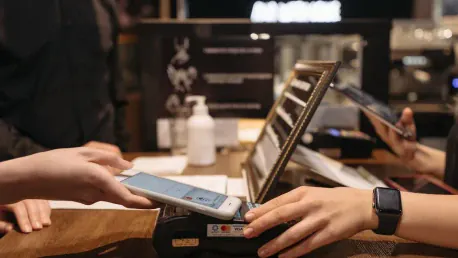Listen to the Article
Businesses and consumers alike must adapt to the ongoing move away from physical payment methods. Fintech trends like Near-Field Communication technology and virtual cards have transformed how transactions take place, offering payers more security and enabling more frictionless buying experiences. But how does this affect B2B trade?
This article will explore the influence of virtual payment solutions on expense management in today’s dynamic business environment—and how they support the ongoing transformation of organizational finance and banking functions.
What’s a Virtual Card?
Virtual cards are digital payment solutions that provide everything their traditional counterparts can, without the physical burden. As the speed and scale of online purchases grow, virtual cards also help retail, and e-commerce businesses manage evolving customer expectations for flexibility and choice.
So, how exactly does it work?
Near-field communication, a set of wireless communication technologies, is what gives virtual cards the power to exist. It enables contactless or tap-to-pay capabilities, allowing a secure transfer of data without having to manually insert the card into a reader device.
To replace the need for a conventional plastic card equipped with near-field communication functionality, software companies like Apple have consolidated the functionality into smartphones for all-around convenience. Since the advent of digital wallets in 2011, virtual cards took smart payments one step further with the launch of Apple Pay three years later.
Offer more than just ease-of-use, virtual cards also address some longstanding limitations of traditional payment solutions. Checks and Automated Clearance House transactions take time to process, creating uncertainty as to when the receiver will be paid, while virtual cards foster confidence that payments will be made immediately.
These flexibility benefits are undoubtedly part of the reason that the virtual card market is predicted to increase at a compound annual growth rate of 21.3% to $3980.06 billion by 2034.
Yet, a number of leading industries can’t seem to progress beyond legacy payment approaches. In construction, 76% of subcontractors still use paper-based methods, while the real estate (21%) and retail (15%) sectors remain largely unchanged in their check usage.
Key Adoption Drivers
Streamlining Accounts Payable
Recent estimations show that sticking with legacy Accounts Payable and Accounts Receivable processes could collectively cost U.S. businesses over $100 million. However, many are still afraid to digitally transform their accounting systems for fear of cybercrime or incidents that could damage client relationships.
But as the benefits of accounting digitization become clearer, more savvy finance leaders are realizing the advantages of virtual cards. Managing outstanding supplier and vendor payments efficiently is critical to maintaining strong partner relationships and ensuring healthy cash flow.
With virtual cards, the longstanding balance of power is shifting away from B2B buyers. Quicker payments mean that suppliers can ensure certainty in purchase volumes and get paid more immediacy by incentivizing quicker payouts through enticing discounts.
Simplified financial reconciliation
Finance and accounting professionals spend a disproportionate amount of time on reconciliation tasks, making virtual cards’ quick processing times a welcome addition for these teams. Digital transactions automatically generate a ‘paper trail’ of critical information—like invoice data and supplier details—eliminating reliance on receipts and the clear challenges that unidentifiable transactions create.
The goal of financial reconciliation is to verify and check that financial records are accurate and correct any discrepancies. Digital payments clearly benefit this critical process, accelerating often time-consuming and tedious financial close operations.
Real-time security
Spending limits, expiration dates, and customizable merchant restrictions make virtual cards a much more secure alternative to traditional approaches, improving control and management.
Eliminating physical cards inherently reduces the risk of fraud, as entering card information online increases vulnerability to information theft. It also mitigates obvious opportunities for misuse, unauthorized spending, and loss.
Virtual card transactions generate unique numbers that change with each purchase, significantly lowering the chances that bad actors could gain unauthorized access to the owners’ sensitive data.
When B2B buyers and suppliers across lagging industries fully embrace virtual cards for expense management, they unlock all the above benefits, plus additional advantages that individual users aren’t typically concerned about.
Leading B2B Virtual Card Offerings
The boom of fintech and digital transformation in finance and banking naturally has led to an equally large explosion of payment technology providers.
Depending on your unique business use cases and needs, finding the right partner can be difficult. Here are some options to help simplify your search:
Wallester provides leading virtual card services to empower team spending with configurable controls, make cross-border payments, and receive real-time alerts for overspending.
With Revolut, businesses enjoy seamless mobile user experiences, the exchange of crypto and foreign currencies, and no hidden fees.
Airbase stands out for its spend monitoring capabilities, global invoice capture, and advanced, vendor-specific design.
Intergiro empowers online advertisers with seamless integrations with major platforms, group sub-accounts with controls, and automation-enabled workflows.
A Few Limitations to be Aware of
In spite of the overwhelming edge virtual cards offer, many businesses have fully embraced them due to a lack of confidence in the technology—which is sometimes justified.
The ingrained nature of B2B payments, coming from decades back, has yet to catch up with the efficiency of digital transactions in some aspects. Here are a few ways that they may hold your business back:
B2B payments often involve large sums of money, which can lead to hesitance or concern from professionals who are accustomed to traditional payment methods.
Expired issuance numbers may make it difficult for businesses to verify purchases or request refunds.
Entering remittance information into enterprise resource planning software must sometimes be done manually.
Suppliers may experience high interchange fees.
Offline transactions cannot be done using virtual cards.
Future Outlook
Needless to say, the trend of using virtual cards for B2B payments has staying power—and this dominance is supported by the rise of innovative fintech companies that are making tech-driven payments more accessible, extending the presence of cardless payments from large and multinational companies to small and mid-sized B2B businesses. The flexibility, convenience, and security benefits of virtual card technology are too glaring for businesses and suppliers to ignore for much longer, and promise to reshape B2B and B2C payments in 2025 and beyond.









